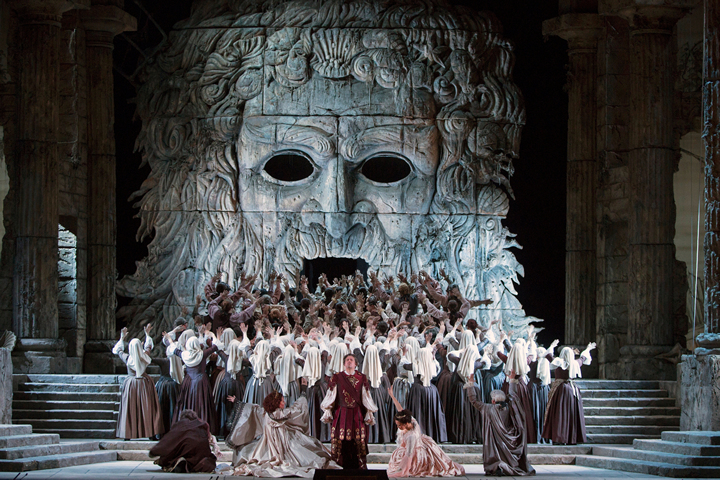
Idomeneo by Wolfgang Amadeus Mozart. Metropolitan Opera, 2017.
Mozart’s Idomeneo is a landmark opera and deserves the effort that James Levine has put into its revival. Even though it lacks the fire of Don Giovanni and the heart of Nozze di Figaro, Idomeneo is a significant achievement by a 25-year-old composer on the cusp of a memorable career. It was never performed at the Metropolitan Opera until Levine led it in 1982.
Fathom Events broadcast Idomeneo in cinemas worldwide as part of its series of operas in HD. During intermission we saw a lengthy and revealing 1988 documentary of James Levine preparing a production of Ariadne auf Naxos with Jessye Norman, Kathleen Battle and Tatyana Troyanos. It shows Levine’s extraordinary talent for empathizing with his singers and working with them to shape the music. He is now in semi-retirement, and this is one of only three operas which he chose to lead at the Met this season.
Idomeneo was written with an Italian libretto by this Austrian composer for a German opera house, and was based on a French model. Mozart followed the style of Christoph Willibald Gluck, the renowned composer of eight French operas. Mozart conducted the world premiere of Idomeneo in Munich in 1781.
In this art form called opera seria the subjects were noble and the movements were formal. Musical numbers follow a pattern of recitatives which advance the dramatic action, followed by arias that reflect characters’s feelings, with lengthy comments by the chorus. Idomeneo thus has a measured dignity and the grandeur of Greek tragedy.
The style of Idomeneo’s choruses and marches is French, and its shipwreck scene is almost identical to a scene in Gluck’s Iphigénie en Tauride, which had premiered in Paris two years earlier. Gluck’s title character interrupts a storm to plead for the goddess Diane to end the tempest. In Mozart’s opera, King Idomeneo of Crete pleads for the god Neptune to do the same. On his way back from the Trojan War, Idomeneo’s ship encounters a terrible storm. He prays to Neptune and promises that, if Neptune will save his ship, he will sacrifice the first living thing he sees when he returns home. The first living thing is his son, Idamante.
Meanwhile, Idamante has fallen in love with Ilia, daughter of the defeated Trojan King Priam, who was taken to Crete after the war as a slave.
Drama about human sacrifice horrified but fascinated audiences. Mozart built on the dark spirit of uncertainty and wrote ominous trills for the scene when Idomeneo is about to have his son killed. At the end, Neptune spares Idamante, on condition that Idomeneo relinquish his throne to a new generation, and Idamante becomes the new ruler along with his bride, the sweet young Ilia.
The last act is awesome, with more personal revelations than was the norm in operas of that period. Solo oboe melodies provide poignancy. In the sacrifice chorus, “O voto tremendo”, the bass line curls around the main melody with dissonant upper and lower tones. Mozart is often thought of as a simpler, gentler, more innocent predecessor of Beethoven. But in Idomeneo we hear more musical dissonances than you’ll find in Beethoven’s vocal works. This is quite an adventurous piece, and I understand why James Levine crusaded to give it a place in the Met’s repertory.
Mozart ended the opera with a multi-part chaconne in the French manner. In his much later The Magic Flute, a festive ending is marked by loud triumphal music; and Beethoven did the same at the end of his only opera, Fidelio. Even in Mozart’s later opera seria, La clemenza di Tito, the joyous conclusion is marked by a loud unison march. But here in Idomeneo the happy celebration pauses to allow extended, subtle passages for soft woodwinds.
Mozart composed the title role for a castrato, a man who was castrated for the purpose of making his voice high and light. For a production in Vienna in 1786, Mozart wrote some new passages, and changed Idamante from a castrato into a tenor. What the Met is presenting here is an amalgam. The title role is sung by a tenor (indeed, you can’t find castrati in any opera company these days) but he sings the elaborate and florid music from Mozart’s Munich score.
When Pavarotti in 1986 and Domingo in 1995 sang the role of Idomeneo at the Met, they performed the simplified version of the hero’s aria, “Fuor del mar” (“Out of the sea”); Matthew Polenzani sang the more challenging Munich version. Polenzani’s voice lacks the thrusting brilliance of those two tenors, but he brings greater sweetness and elegance, along with a mastery of the vocal ornamentation.
The young soprano Nadine Sierra was captivating as Ilia. Her voice seems small in size but has a warm quality, and she sings with grace, refinement, and long phrasing. Mezzo-soprano Alice Coote sang Idamante with dignity, and Dutch soprano Elza van den Heever played the menacing Elettra (the Italian spelling for Elektra) who fled to Crete after the murder of her father, King Agamemnon. She too is in love with Idamante and her jealous rage against Ilia provided a show-stopping aria. Eric Owens impressively sang the unseen voice of Neptune.
All in all, this was the most refined and evenly balanced of the seven Idomeneos that I’ve heard since 1983, but some of the earlier revivals had more excitement. The Met orchestra played masterfully under Levine’s leadership, and the Met chorus, trained by Donald Palumbo, was fabulous. Everyone on stage moved in stylized manner on a set that was formally balanced with stairs and columns. A giant head of Neptune, with an open mouth, dominated center stage.
TV director Barbara Willis Sweete moved her cameras within the parameters of the formally balanced stage movements created by the late Jean-Pierre Ponnelle.
This was not a production to excite the passions but, rather, it earns appreciation for an intriguing composition and an ensemble of elegant performances.